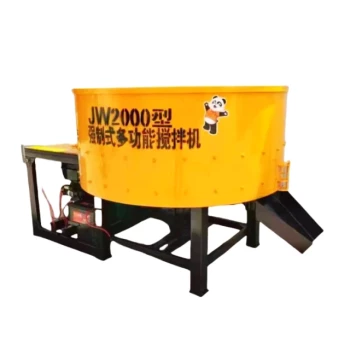Cement mixer trucks can be filled using two primary methods: the central mix plant method where concrete is pre-mixed before loading, and the transit mix method where raw materials are loaded separately and mixed during transportation. The sequence of adding materials—water, cement, aggregates, and sand—plays a crucial role in ensuring even mixing and optimal concrete quality. Proper batching and gradual water addition are key to achieving the desired consistency without overloading the mixer.
Key Points Explained:
-
Central Mix Plant Method
- Concrete is pre-mixed at a batching plant before being loaded into the cement mixer machine.
- Ensures uniformity and consistency before transportation.
- Ideal for projects requiring precise mix ratios and large-scale production.
-
Transit Mix (Dry Batch) Method
- Raw materials (cement, aggregates, sand) are loaded separately into the drum.
- Water is added either at the plant or en route, with mixing occurring during transit.
- Offers flexibility in adjusting mix consistency on-site.
-
Material Loading Sequence
-
Water-first approach:
- Start with half the water to coat the drum.
- Add cement, followed by aggregates (gravel) and sand.
- Gradually add remaining water to achieve the desired slump.
-
Alternative sequences:
- Some operators prefer adding aggregates first to prevent cement clumping.
- Ensures even distribution and reduces segregation risk.
-
Water-first approach:
-
Mixing Process Considerations
- Drum rotation speed: Critical for blending materials without overmixing.
- Batch size: Avoid overloading to maintain mixing efficiency.
- Gradual water addition: Prevents uneven hydration and improves workability.
-
Applications Influencing Filling Method
- Central mix: Preferred for high-strength applications like multi-story buildings.
- Transit mix: Suitable for remote sites or projects requiring on-the-fly adjustments (e.g., road construction).
Have you considered how the choice between these methods impacts project timelines and material waste? These technologies quietly shape modern infrastructure, from sidewalks to skyscrapers.
Summary Table:
| Method | Process | Best For |
|---|---|---|
| Central Mix Plant | Pre-mixed concrete loaded into the truck at the plant. | Large-scale projects requiring precise mix ratios (e.g., high-rise buildings). |
| Transit Mix | Raw materials loaded separately; mixed during transit with water added later. | Remote sites or projects needing on-site mix adjustments (e.g., road construction). |
Key Loading Sequence Tips
- Water-first: Start with half the water to coat the drum, then add cement, aggregates, and sand.
- Gradual water addition: Prevents uneven hydration and improves workability.
- Avoid overloading: Maintains mixing efficiency and consistency.
Need a reliable cement mixer truck for your construction project?
At GARLWAY, we specialize in high-performance concrete mixer trucks and batching plants designed for efficiency and durability. Whether you're working on skyscrapers or roadways, our solutions ensure optimal mix quality and reduced waste. Contact our team today to discuss your project needs!
Related Products
- Mini Cement Mortar Mixer Truck for Construction
- HZS25 Best Cement Mixer for Quick Mix Concrete at Bunnings
- JZC500 Large Cement Mixer Machine Price for Concrete Mix
- JDC350 Small Cement Concrete Mortar Mixer
- JZC1000 Industrial Concrete Mixer Machine Cement Mixer Price
People Also Ask
- What are the common uses of cement mixer trucks? Essential for Construction Efficiency
- What happens if cement dries inside the truck? Avoid Costly Damage & Downtime
- How do concrete transport trucks work? The Science Behind Efficient Concrete Delivery
- What makes towable cement mixers suitable for certain projects? Portable, Efficient, and Adaptable Solutions
- What are the benefits of using a portable cement mixer? Boost Efficiency & Flexibility on Job Sites



















